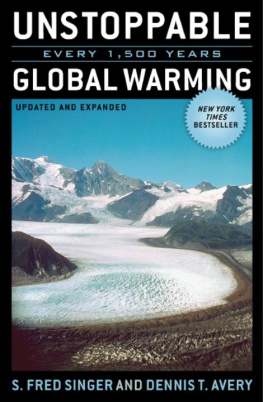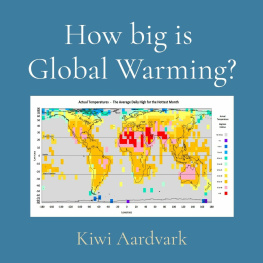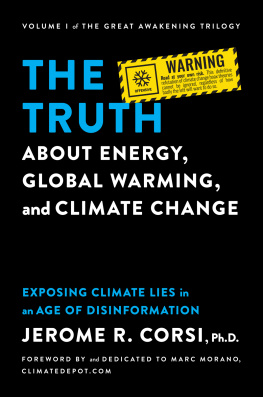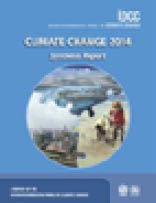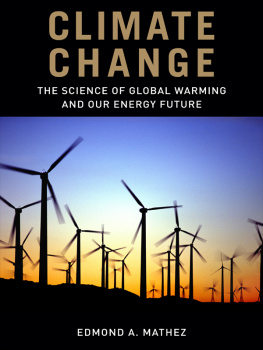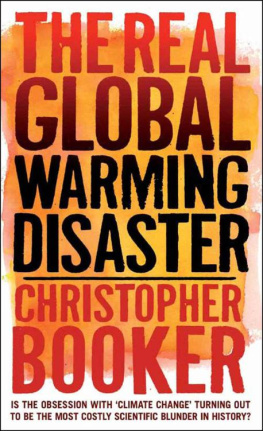S. Fred Singer and Dennis T. Avery





This book is dedicated to those thousands of highly qualified research scientists who have documented physical evidence of the 1,500-year climate cycle from over the entire globe. Hundreds of their studies endorse the reality of this cycle. They have gone, literally, to the ends of the Earth-often in harsh conditions, climbing tall mountains and huge glaciers, sailing frigid seas, sitting cramped at consoles in long-range aircraft, digging painstakingly in remote sites for pollen and human artifacts-to help us understand our planet's climate changes. They have done it with virtually no encouragement from the press and the public. Too often, they have had to work in the face of hostility from their colleagues in the climate modeling community who are "selling" CO2. They have done it in a sincere effort to help produce public policies that will maximize both human and ecological well-being. We applaud them and their work.
The three scientists, Willi Dansgaard of Denmark, Hans Oeschger of Switzerland, and Claude Lorius of France, who led the discovery of the 1,500-year cycle, were jointly awarded the Tyler Prize (the "environmental Nobel") in 1996. However, their award citations say nary a word about the climate cycle they discovered, nor anything about its predictive power to forecast moderate climate changes. The public has remained virtually unaware that the 1,500-year cycle offers the only explanation for the modern warming that is supported by physical evidence.
ix
xi
xiii
Figure 1.1: Global Satellite Temperature Record 1979-2004 11
Figure 5.1: IPCC's 1995 Earth Temperature History 68
Figure 5.2: IPCC's "Hockey Stick," 2001 69
Figure 9.1: Chinese Temperature History 131
Figure 9.2: Siberian Temperature History 144
Figure 9.3: South African Temperature History 147
Figure 13.1: Earth's Temperatures Related to Solar Cycles 192
When Eric the Red led Norse families to settle on Greenland toward the end of the tenth century, he had no idea that he and his descendants were about to demonstrate the Earth's long, moderate climate cycle as dramatically as it would ever be done.
Sailing their longships west from Iceland, the Vikings had been pleased to find a huge new uninhabited island, its shores covered with green grass for their cattle and sheep, surrounded by ice-free waters where codfish and seals abounded. They could grow vegetables for their families and hay to feed their animals through the winter. There was no timber but they could ship dried fish, sealskins, and tough rope made from walrus hide to other Norse ports to trade for what they needed. The colony thrived, growing by the year 1100 to three thousand people, with twelve churches and its own bishop. The initial settlement split into two: one on the southwestern coast and one further north also on the west coast.
They did not realize that they were benefiting from the Medieval Warming, a major climate shift-which lasted for approximately four hundred yearsthat made Northern Europe about 2 Celsius warmer than it had been previously. Nor did they realize that after the warming ended, their grassy domain was doomed to five hundred years-the Little Ice Age-of icy temperatures unmoderated by the Gulf Stream that warmed the Norse settlements in Norway and Iceland.
As the Little Ice Age progressed, the colony was increasingly hard-pressed to survive. The pack ice moved closer to Greenland. Supply ships had to take a more southerly route to avoid the deadly ice. Less and less hay could be harvested in the shorter, cooler summers to last the livestock through longer and colder winters. The storms got worse.
By 1350, glaciers had crushed the northern Greenland settlement. The last supply ship got through to the southern settlements in 1410; then they were cut off. There was fighting with Inuit hunters pushed south by the encroaching ice to compete with the Norse for the seals. The codfish followed the warm water south, away from the colonies. The skeletons in the graveyards show the people growing shorter- indicating poor nutrition.
We do not know whether the last colonists died at the hands of the Inuit, or froze or starved to death, or even just when they died. We do know they had eaten the last of their milk cows -a desperate act for dairy farmers. Measuring the change in oxygen isotopes of Greenland Norse skeletons' tooth enamel indicates a 1.5-degree Celsius drop in average temperatures between the years 1100 and 1400.
Denmark would not recolonize Greenland until 1721, when the Little Ice Age was losing its grip on the huge island.
Today, 150 years into the Modern Warming, Greenland has 50,000 people and 20,000 sheep. Most of the people earn their living by catching shrimp and fish, though there is a short summer season for hardy tourists. The ruins of the Norse cathedral and the bishop's palace have been partially restored as a beautiful memorial to Greenland's Norse era.
Greenland is likely to become even more popular as a tourist attraction for as long as the Modern Warming lasts -probably at least several hundred more years. But the ice cores and seabed sediments tell us of six hundred natural 1,500-year climate cycles over the past one million years. The cycle will eventually shift again and Greenland will once more descend into ice and hardship.
The only significant difference between the fifteenth century's Little Ice Age and the next is likely to be in the human technology available to cope with it. The twenty-fifth century's Greenlanders will have better insulation and bigger, safer fishing vessels than did their ancestors, plus satellite communications and powerful, ice-breaking supply ships.
ANCIENT CLIMATE HISTORY
4.5 billion years ago: Earth created.
3.8 billion years ago: Single-cell life forms created.
1.9 billion years ago: Nitrogen-dominated atmosphere replaced by oxygenrich atmosphere.
540 million years ago: Earth apparently turned from "ice ball" into a warm and humid world. Simple microbes in the ocean transform into thousands of new species, founding the evolution of today's life forms.
350 to 250 million years ago: Ice sheets reappear at higher Earth latitudes. There is only one large continental landmass, Gondwana, in the southern hemisphere.

